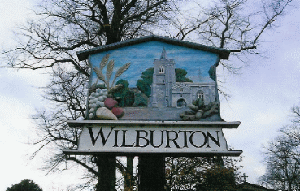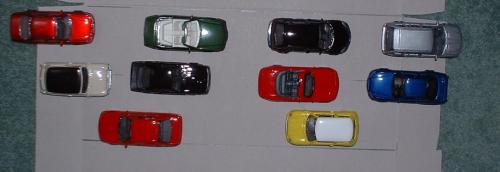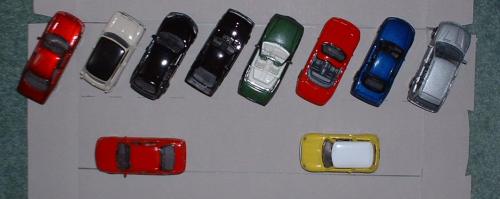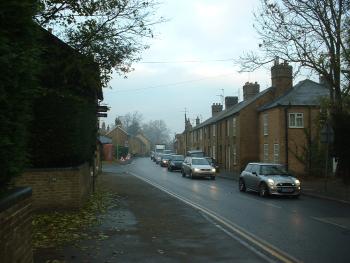
|
WAGONSWilburton Action Group Oppose New SettlementThe proposed development will effectively merge Wilburton and Strethaminto suburbs of a mini Milton Keynes, be a blot on the landscape and cause traffic grid-lock. Do you want that to happen? Send us your views so we can include them! Wilburton Public Meeting - an overview |
| The A10 | Park and Ride | Other Villages |
The A10
The proposals for the A10 seemed to cause a lot of discussion at the public exhibitions in Wilburton and Stretham - local knowledge of travelling on the road painting a different picture to a few days of automated traffic counting.
The main hub of the proposals is geared towards the figures of up to 50% increase in capacity, and up to 30% increase in safety, by increasing the width of the road from around 7.3m to 10m. How these figures come about was a question often asked at the public exhibitions - the capacity increase comes from being able to over take slower taffic (obviously being out here in the country, we have a lot of tractors going up and down the A10 all the time!). But you can only overtake something if the road ahead is clear - the A10 is nose to tail traffic during the peak times, and often outside of those as well, so unless someone wants to run the guantlet of driving down the middle of the road, then overtaking will be restricted to the odd tractor (or broken down park and ride bus).
The developer had 'examples' of 10m wide roads on display at the Stretham public exhibition - consisting of 3 pictures of the same road, a virtually empty A46 at Stratford-upon-Avon. It would appear that this stretch is a by-pass, built to supplement the existing roads - taking through traffic away from the town centre. It is unlikely that such a by-pass will have the density of traffic flow that the A10 has during peak times, as much of the traffic would head into Stratford-upon-Avon along the A439, A3400 and A422 - which still become congested (source).
The proposal to widen the road also comes with proposals for many junction improvements - such as dedicated right turn lanes. This would in turn restrict the available width of the road at those junctions, reducing any perceived capacity benefits - as the people turning right would want to be protected from traffic which may be attempting to overtake. Over the length of the A10 in question, there are 20 such junctions - not including the A14 Milton roundabout and the Mereham development roundabout, or junctions near to the Research Park and Waste Management roundabouts. Taking this stretch of road as being around 10 miles, on average there is a width reduction junction every half a mile. Add in proposed bus priority at some junctions - then there is not much scope for improved capacity, certainly not 50%. And presumably, most overtaking would involve passing the Park and Ride buses, which then go ahead at the next priority junction.
Increasing Capacity
We have tried to work out how to squeeze an extra 50% safely onto the road - and using a Blue Peter style scale model with model cars and a cereal packet - we have concluded that it is possible - see below. (these cars are taken as being scaled down from approximately 2m width, and the road width drawn accordingly)

Mock-up of Traffic on the current A10

Mock-up of 50% Extra Traffic on the wider A10 - note
the potential of a crash between the blue and red car

Mock-up of 50% Extra Traffic, safely
Yes, by parking your car in the wider carriageway, and waiting for a bus to come along (sorry, we do not have a Park and Ride toy for demonstration, but assume one will be coming along in the next 10 minutes), it is possible to safely squeeze 50% more cars onto the A10.
Joking aside, Cambridgeshire County Council have expressed concerns over the A10 widening plans - and on the 11th April 2005 sent a letter to David Tucker Associates stating:
The form of carriageway widening will depend on the outcome transport assessment. It is understood that widening to 10m wide single carriageways would not normally be acceptable on road safety grounds within Cambridgeshire, and that any link capacity increases could only therefore be achieved by widening to dual carriageway standard.
As for other proposals for a "multi-modal corridor based approach. This will consist of public transport, cycling and pedestrian improvements" (transportation assessment document, 3.3.11). Where are people expected to cycle or walk to? Ely? Cambridge? It gets very dark out there at night, we suggest the developers try cycling along the A10 during a winter evening.
Traffic Flows and the B1049
Some of the traffic flow analysis presented in the transport assessment documentation seems to be wholly inadequate - being based on a 'peak hour' of 8am-9am traffic count undertaken on one particular date (12th October 2004). When asked, David Tucker actually tried to deny that this was the level of traffic analysis, and did not seem to know when the peak hour of the local roads is. To be able to set off for work at 8:30am and arrive in Cambridge city centre by 9am is just not possible! At the Stretham public exhibition a bus user pointed out it takes an hour by bus to Cambridge, and a Cottenham business owner said it now takes 30-45 minutes at 7:30am to get to the A14 roundabout south of Histon.
In summary, the following traffic counts were undertaken:
Peak Hour (8am-9am, 5pm-6pm), on 12th October 2004
- A1123/B1049 - Wilburton junction (outside Wilburton Post Office)
- A1421/A1123 - Haddenham junction
- A10/Ely Southern Bypass junction
- A10/Cambridge Research Park
- A10/School Lane junction
12 hour count - 12th October 2004
- A10/A1123 Stretham roundabout
Automated traffic count - 11/10/04 - 24/10/04
- A10 south of A10/A1123 Stretham roundabout
- A10 north of A10/A1123 Stretham roundabout
- A10 east of A10/A1123 Stretham roundabout
- A10 west of A10/A1123 Stretham roundabout
Apart from the longer automated count - the single day counts do not give a good overview of the traffic flows in the area. Anyone who uses the B1049/A1123 (Twenty Pence road) junction will know that traffic flows can vary quite considerably. Recently, a road closure in Cottenham caused tail backs down the B1049 as far as the River Ouse bridge.
From the traffic assessment (and speaking to David Tucker), the developers seem to ignore any increase in the level of traffic going into Wilburton and down the B1049. This is already a busy road, but was deemed by David Tucker to be outside of the scope of the development. With the proposal now containing an access from the development onto the A1123, where do they expect the traffic to go?
This point is picked up by the Cambridgesgire County Council in their April letter, and more recently in their press release. From the letter:
The need and justification for the secondary access will be dependent on the outcome of the transport assessment - would if form an alternative route to Cambridge via Wilburton and the B1049, and thus would it cause an increase in traffic through Wilburton and Cottenham etc.
The need for a secondary access is fairly obvious from a development point of view - a site the size of Mereham would require more than one entrance/exit (heaven forbid there should be an accident on the exit onto the A10) - particularly at peak times when attempting to exit onto a busy road such as the A10. The consequences of such a secondary access on Wilburton, and possibly Haddenham, just do not seem to have been investigated. Wilburton is already busy, a photograph taken on the High Street highlights this (see below). Traffic levels through Cottenham and Histon are also high - alas there does not seem to be any evidence of a count at Histon attempting to cross the A14. Hint - it is very busy, from around 7:30am onwards. And with the new development being built on the Cambridge side of the A14 traffic levels will increase further.
